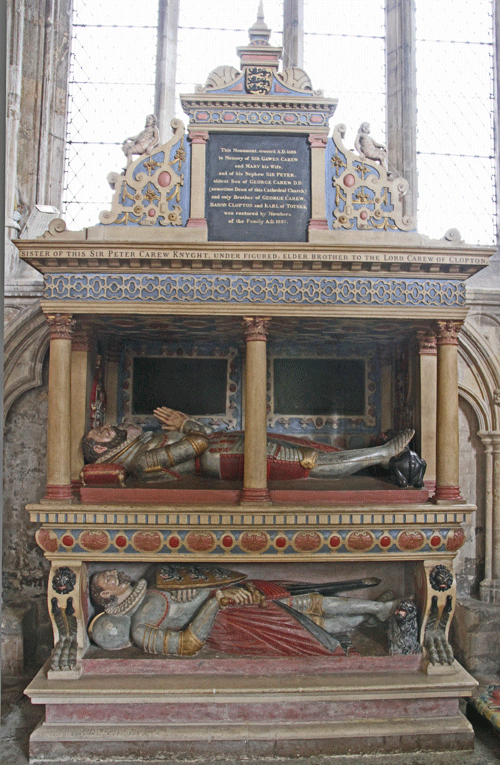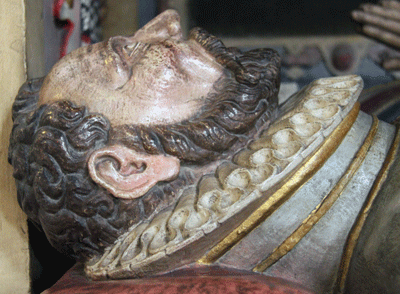| DEVON - CITY OF EXETER - THE CATHEDRAL |

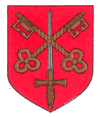

I have divided the page into sections for each part of the cathedral, arranged in way you might travel around the church when you visit. The entrance is the north door of the west wall of the nave so turn round, look at the easily missed west wall and then walk down the north aisle of the nave...etc. Unfortunately the monuments in each section have necessarily been arranged according to layout requirements and not accoring to geography or history!
| There is no parking at the cathedral and although there is some street parking in the City, it is better to use one of the pay & display car parks. I found that the Quay car park was the best: it is near the cathedral (and the other churches as well), long stay and relatively inexpensive. It is signposted. Cost of entry is now £7.50; there are also concessions. When I last visited there was no extra charge for photgraphy. Cathedral website; Wikipedia entry. |
| The Chancel Choir (North Aisle) Choir (South Aisle) The
Lady Chapel Nave (North Aisle) Nave
(South Aisle) Nave (West Wall)
North Transept South
Transept North East Chapel North West Chapel The Oldham Chantry The Refectory The Retrochoir South East Chapel Speake Chantry <Home - Index -Page> <Exeter Churches> <Devon-A> <Devon-B> <Devon-C> Please note: this page is unfinished particularly with regard to some of the text, especially the index below and some of the information. It also needs to be proof read. I have another large batch of photographs so I am halting the Devon project for the time being while I work on these new photographs. I will work on the revision of Devon-C next and then begin on the new work. |
| West Wall of Nave |
  Above Top: Richard Doddridge Blackmore (1900) Barrister of Middle Temple and the author of Lorna Doone. By Harry Hems Above Bottom: Portions of the west front were restored in memory of George Gould (1928) churchwarden of Anerley, Teignmouth. |
  Above Top: Frederick Temple (1902) Headmaster of Rugby School and subsequently Bishop of Exeter, London and Archbishop of Canterbury. Above Botom: Christopher Turner Johnson MRCS (1811) Surgeon and anatomical lecturer. Occulist of the West of England Eye Infirmary. |
 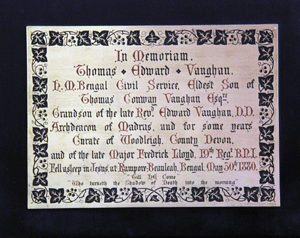 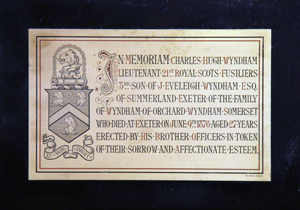 Above Top: John Samuel Champion Davis CBE VD DL (1926) County Director of the Red Cross. Above Middle:Thomas Edward Vaughan (1800) H M Bengal Civil Service Above Bottom: Lt Charles Hugh Wyndham (1876 at 27) 21st Royal Scots Fusiliers. Signed Cox & Sons, London |
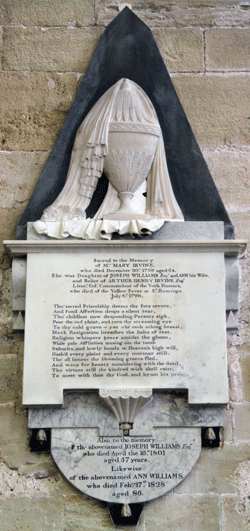 |
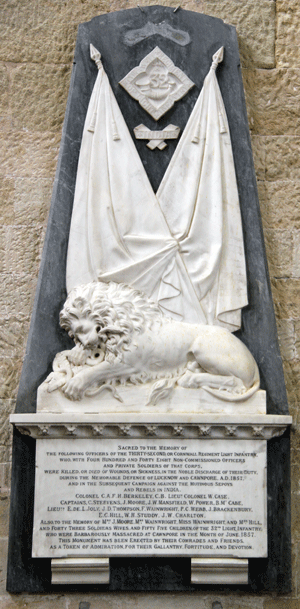 : |
| Above Left:Mrs Mary Irvine
(1799)
She died of yellow fever at 24 at St Domingo; also her
parents Joseph (1801) and Ann (1928)
Williams' Above Right: ...officers of the 32nd or Cornwall Regiment of Light Infantry who with 448 NCO's and private soldiers were killed or died of wounds or sickness during the defence of Lucknow and Cawnpore 1857 and in the subsequent campaigns against mutinous Sepoys and rebels... Col C A F H Barkely CB, Lt Col W Case, Cpts C Steevens, J Moore, J W Mansfield, W Power, B McCabe, Lts E deL Joly, J D Thompson, F Wainwright, P C Webb, J Brackenbury, E C Hill, W H Studdy & J W Charlton. Also to Mrs J Moore, Mrs Wainwright, Miss Winwright, Mrs Hill and 43 soldiers' wives and 55 children who were barbarously massacred at Caenpore, June 1857. |
||||
| North West Chapel |
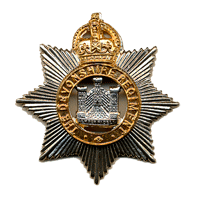 |
This chapel is that of the Devonshire Regiment, which was a line regiment of the British Army and which served under various titles and in many wars, including the Boer War, World War I and World War II. Three Victoria Crosses were awarded, the memorial to one of these recipients being shown below. It was amalgamated with the Dorset Regiment in 1958 to form the Devon and Dorset Regiment and then in 2007 amalgamated with four other regiments to form a large regiment, The Rifles. |
 Mjr-Gen. C W Park CB (1913) For the engagement at Wagon Hill in the Boer War, click the link. |
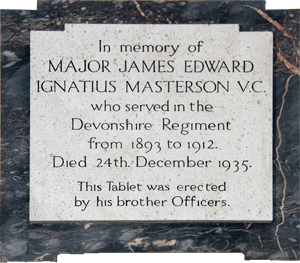 Above: Major James Edward Ignaius Masterson VC (1912) An Irishman who served in the Devonshire Regiment 1893-13 and won the VC in the same campaign as above. Right,Top Left: Sub-Lt Clifford Cruse (1877). Drowned at Poons, Bombay aged 20. Lt Percy Frith Reid (1883) Died at Agra, Bengal aged 23. Col William Adam Smyth (1885) Died at London aged 46. Lt Dunstan Lovell Gill (1885) Died at Gwaliot, Bengal aged 24 Mjr William Hamilton Marriott (1885) Died at Mussoorie, Bengal aged 41. Right, Top Right: Cpt Allan Laing Peebles (1895) 1st Battalion Devonshire Regiment. '...mortally wounded at Panikora River in the Chitral Expedition....buried at Hok Marsden...aged 31 Right Central: Major General Sir Howard Craufurd Elphinstone VC KGB CMG of the Royal Engineers. Drowned at sea. Right Bottom: Col Harold Street DSO (1959) Colonel of the Devonshire Regiment 1943-48 |
 |
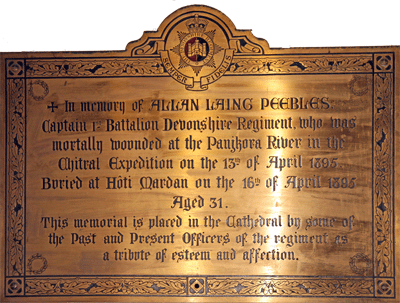 |
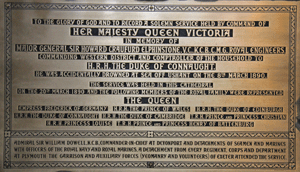 |
|||
 |
|||
| Nave - North Aisle |
 |
 |
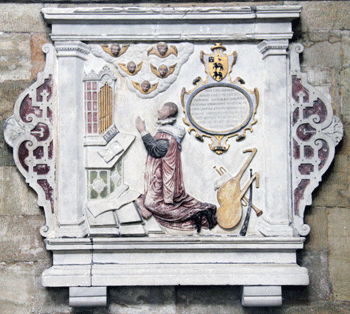  |
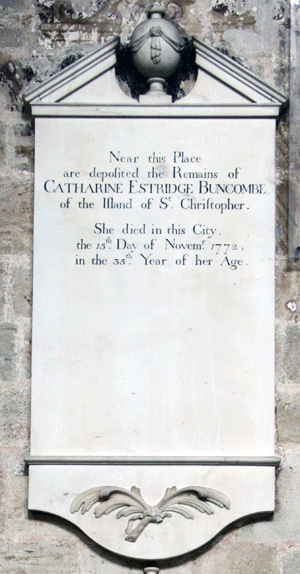 |
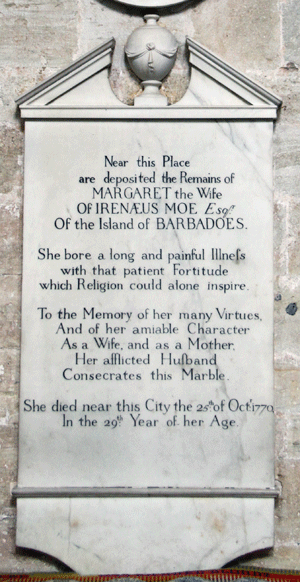 |
| Lt-Col John McDonald
FRS RAS (1831)
Youngest son of Flora McDonald, the Jacobite heroine. He joined the Bengal Engineers /Cartographers. Floor brass in the ST marks his burial site. |
James Bell (1805) He 'died in the vicinity of the city' aged 23 |
Above Top:
Matthew Godwin
(1586 aged 18) Organist and master of music at
Canterbury and Exeter. Note the organ, theorbo and lute. Above Bottom: John George James Heinzelman (1824) |
Above Left: 'Near this
place are depoſited the remains of...'
Catharine Estridge Buncombe
(1772) of the
Island of St Chriſtopher . She died in this city...in the 35th
year of her age'. Above Right: 'Near this place are deposited the remains of...' Margaret, wife of Irenæus Moe of Barbados (1770). Died 'near this city, age 29. Although these two tablets, which are sited one above the other, are very similar in both appearance and date, note the use the letters ſ on the left and s on the right. |
|
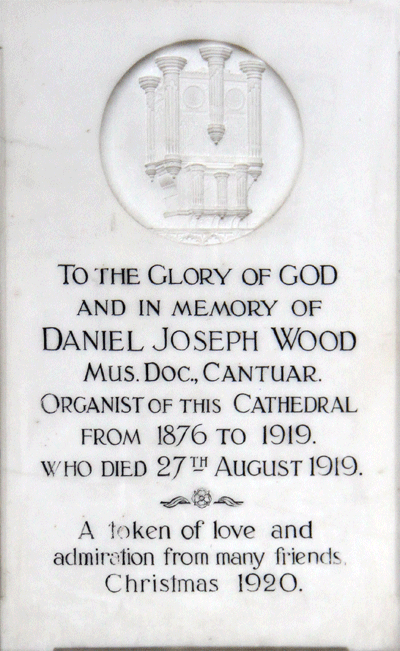 Daniel Joseph Wood Mus. Doc. Cantuar. (1919) Cathedral organist 1876 - 1919 |
  Above Top: Mary Jane Nation (1897) |
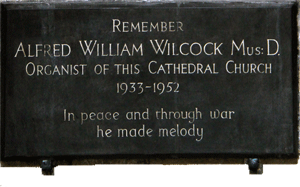 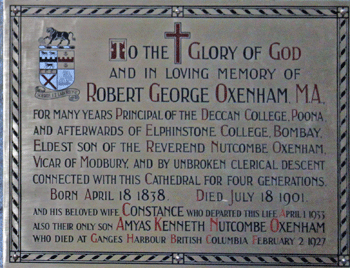 Above Top: Alfred William Wilcock Mus D Cathedral organist 1933-1952 Above Bottom: Robert George Oxenham MA (1901), his wife Constance (1933) and son Amys Kenneth Nutcombe. He was principal of Deccan College. Poona then Elphinstone College, Bombay. Left Bottom: Rev A T R Vicary (1842) and his wife Barbara (1853). He was priest vicar of the Cathedral & Rector of St Paul's in the City. |
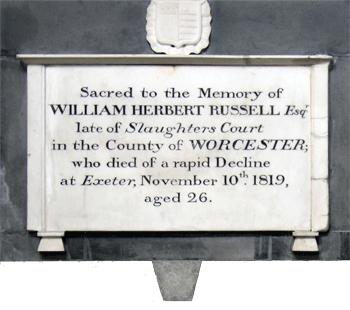   |
 Above Left: Richard (1798) & Elizabeth (1795) Hereford. Above Right :'Near rhis tablet are deposited with his ancestors the remains of...' John Britnell (1837) Left Top: William Herbert Russel (1819) 'late of Slaughters Court, Worcestershire' 'died of a rapid dcline age 26' Left Middle: Jessie Douglas Montgomery (1919) '...worker in the cause of higher education...' Left Bottom: Thomas Armstrong (1994) Exter Organist 1928-33; Christ Church, Oxford 1933-55; Principal, Royal School of Music 1955-68. |
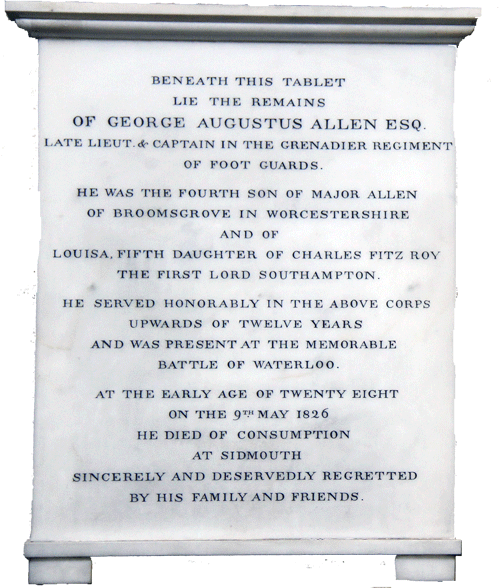 'Beneath this tablet lie the remains of...' George Augustus Allen (1826) . 'Late Lieut & Captain in the Gredadier Regiment of Foot Guards. ..' Present at the Battle of Waterloo. 'At the early age of 28...he died of consumption at Sidmouth. |
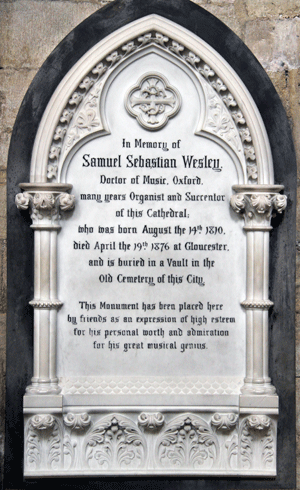 Samuel Sebastian Wesley (1876) Cathedral organist; several of his anthems are still performed. Buried 'in a vault in the Old Cemetery of this City. |
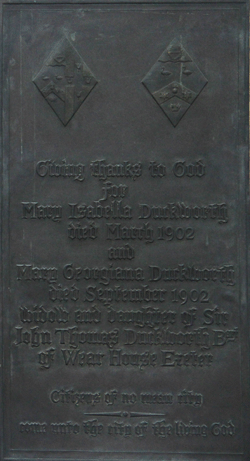 Above: Mary Isabella (1902) & Mary Georgina Duckworth (1902) Mother and daughter. Right: John Horden DD (1895) Bishop of Moosonee; born in Exeter. Wall brass. |
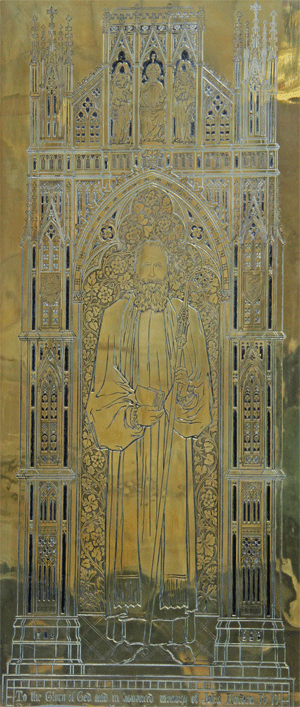 |
| Nave - South Aisle |
 |
  |
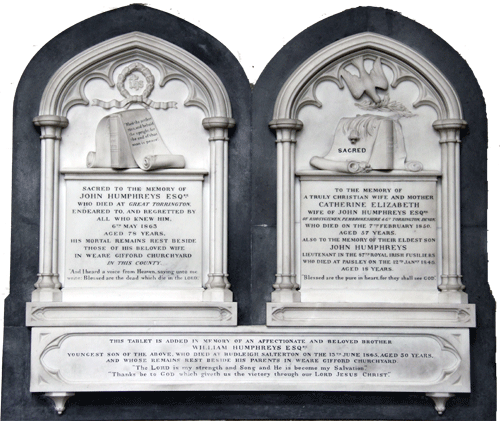 |
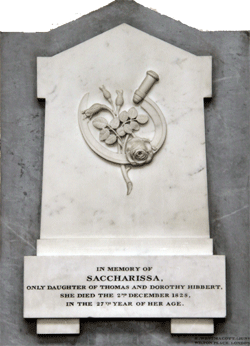 |
| Robert Skinner (1859) '...interred at Thorverton...' | Top:
Cpt Robert Falcon Scott RN CVO (1912) A Devon man
for Oatlands, Devonport. Above is his first expedition flag
presented by his mother. The names of his four companions are
not mentioned. Bottom: Robert George Kekewich (1914) 'The defender of Kimberley' He was an Exeter man and soldier who was promoted to the rank of Major General. He was invalided out of the army but returned to take command in WWI. However being sick and suffering depression he commmited suicide in 1914 and was buried in St Martin's church yard, Exminster. |
John Humphreys (1863) '... his mortal remains rest beside those of his wife in Wear Gifford Churchyard. Catherine Elizabeth (1850), wife of John. Their eldest son John (1845), a lieutenant in the 87th Irish Fusileers, who died at Pailsey aged 18. Below is added William (1865) the youngest son, who died aged 30; '...whose mortal remains rest bedside those of his parents...' | Saccharissa, only daughter of Thomas & Dorothy Hibbert (1828) '...in the 27th year of her age...' Signed: R. Westmacott (Jnr) Wilton Place, London. |
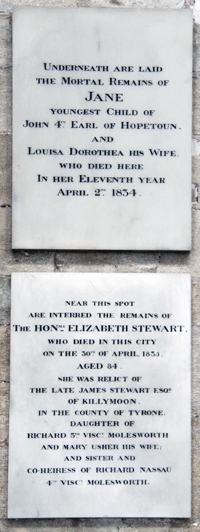 |
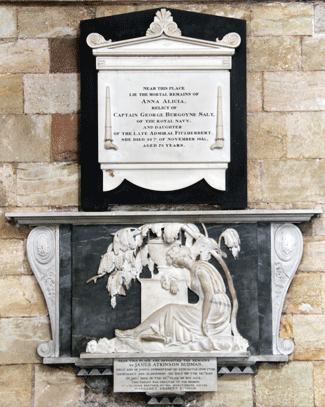 |
 |
 |
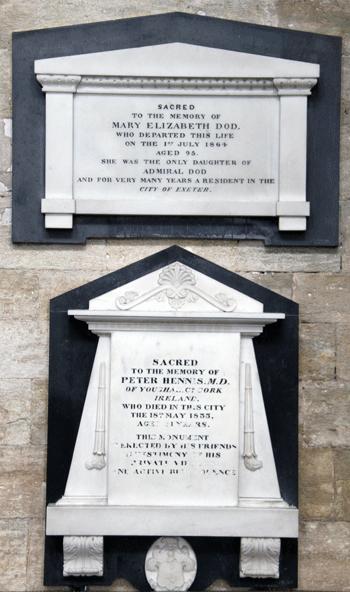 |
|
Top: Underneath are laid the mortal
remains of Jane
youngest
child of John, 4th Earl of Hopetoun & Louisa Dorothea...who died
here in her eleventh year...1834' Bottom: 'Near this spot are interred the remains of The Hon. Elizabeth Stewart (1835)' |
Top: 'Near this spot lie the mortal
remains of...' Anna
Alicia, Relict of Cpt George Burgoyne Salt RN and daughter of Admiral Fitzherbert (1834) Bottom: James Atkinson Rudman (1804) aged 24. See below for a curiosity |
Top: 'T. Okes M. D.
ÆTAT. 66. A.D. 1797.' The rest of
the short inscription is in Greek. Middle: 'In the nave not far from this place are deposited the remains of Hugh, 2nd Earl of Devon (1377) and Margaret his wife (1391). 'by the side of the above are interred the remains of Sir Peter Courtnay (1409) son of the above. Their monument may be seen in the south transept. Bottom; Mjr-Gen Fitz Roy Freemantle CD (1894) Freeman of the City. Colonel Commanding the 11th Regimental District. Signed: Harry Hems & Sons, Exeter. |
Top:
Jane Famin
(1829)
aged 30. Added below (but more worn) her husband
P E Famin (1851) aged 68.
Bottom: 'This window erected to the memory of his friend Thomas Latimer by Sir Edward Watkin Bart. MP was unveiled and dedicated on the 5th July 1889. |
Top:
Mary Elizabeth Dod (1864)
Only daughter of Admiral Dod, died at 95 Bottom: Peter Hennis MD (1833) of Youghal, County Cork. Died at 31 in a duel. He challenged Sir John Jeffcott to a duel after the latter accused Hennis of spreading rumours that may have impeded Jeffcott's marriage to Flora McDonald's grand daughter. Jeffcott fired on hearing the word 'prepare'; Hennis did not fire, forgave his opponent and died eight days later. Jeffcott meanwhile had jumped on a ship to Sierrs Leone where he was chief justice. (Information from Peter Selly) |
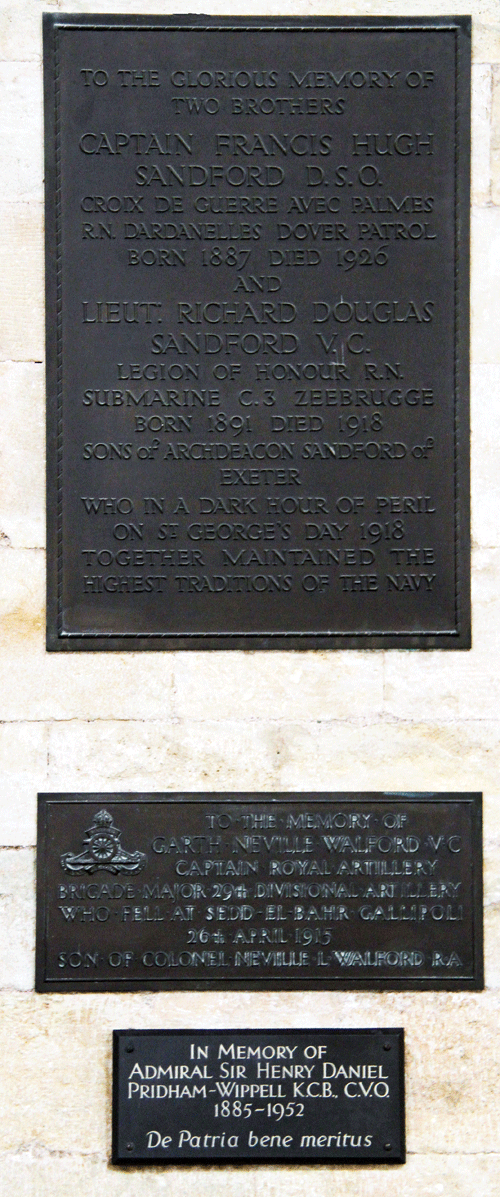 |
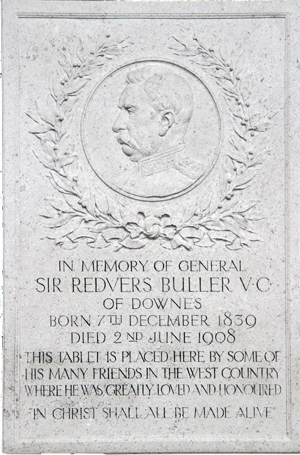 Sir Redvers Buller VC (1908) He was awarded the VC during the Zulu War. A popular general, he was born and died in Crediton where his grave may been seen in the church yard. He has an unusual monument in the church there, an cenotaph with recumbent effigy in Winchester Cathedral and a bronze equatrian statue in Exeter, just outside the college. |
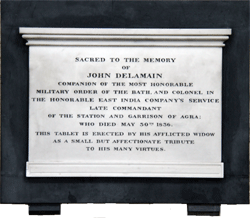 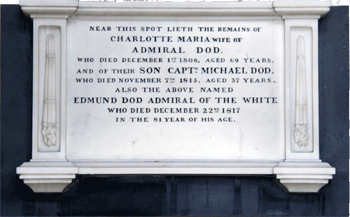 |
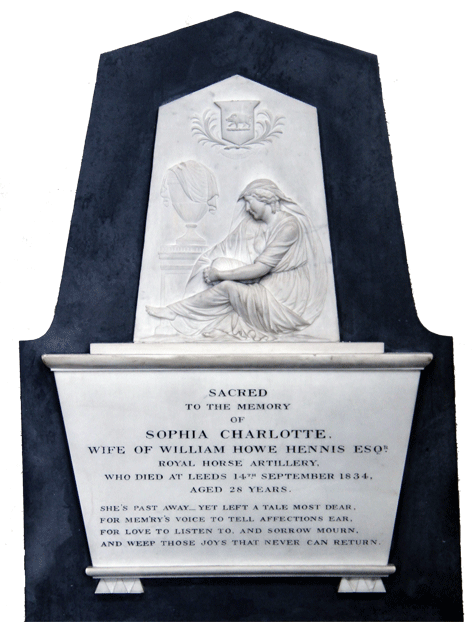 Sophia Charlotte Hennis (1834). Died at Leeds aged 28. By E. Gaffin of Regent Street |
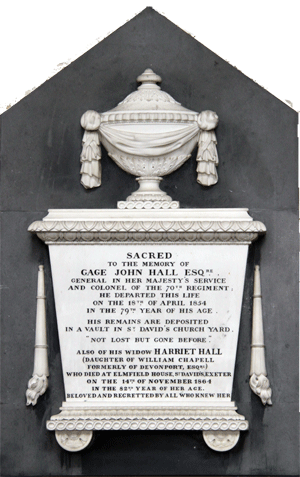 Cage John Hall (1854) General and colonel of the 70th regiment. 'His remains are deposited in a vault in St David's Church Yard' Also his widow Harriet (1834) |
| Top:
Col John Delamain
(1836) 'Companion of the Most Honorable Military Order
of the Bath & Colonel in the Honorable East India Company's
Service. Late Commandant of the Station and Garrison of
Agra.' Bottom: 'Near this spot lieth the remains of Charlotte Maria, wife of Admiral Dod (1808), their son Captain Michael Dod (1815) aged 37, and Admiral Edmund Dod (1817) 'Admiral of the White' |
|
Above Far Left Top: 'To the
glorious memory of two glorious brothers:
Captain Francis Sandford DSO RN
(1926) Croix de Guerre avec Palmes Dardanelles
Dover Patrol, and
Lt Richard Douglas Sandford RN VC
(1918) Legion of Honour Submarine C F Zeebrugge' They
were sons of Archdeacon Sandford of Exeter. Middle: Captain Garth Neville Walford VC (1915) Cpt Royal Artillery Brigade, Major 29th Divisional Artillery. KIA at Sedd-el-Bahr, Gallipoli when he was awarded the VC Top: Admiral Sir Henry David Pridham-Whippel KCB CVO (1952) |
 |
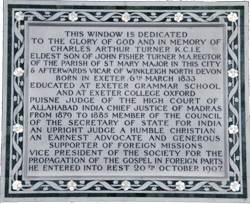 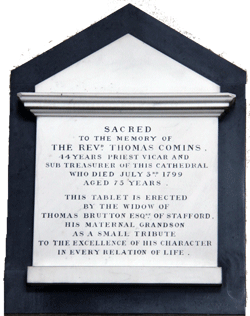 |
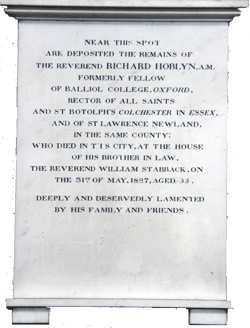 |
 |
| Revd Marmaduke Prickett MA (1839) of Burlington, East Riding of Yorkshire. Late chaplain of Trinity College, Cambridge. Died at Torquay at 34 | Top: The above window is dedicated to
Charles Arthur Turner
KCIE (1907) Puisne judge of the
High Court of Allahabad, India, Chief Justice of Madras, Member
of the Council of the Secretary of State for India Bottom: Rev Thomas Comins (1799) '44 years priest vicar and sub-treasurer' He died aged 75. |
' Near this spot are deposited the remains of The Reverend Richard Hoblyn AM Fellow of Balliol College, Rector of All Saints & St Boltoph in Colchester and of St Lawrence, Newland in the same city...died in the city at the house of his brother-in-law, Reverend William Stabback ' (1827) | Thomas Call (1788) late Lieutenant Colonal Chief engineer in the Service of the Honorable Company of Marchants of England, trading to the East Indies on their Bengal Eſtablishment.' He died age 40 'on board the William Pitt Indiaman when on her Voyage from Calcutta to the Iſland of Great Britain.' |
| Some Wall Brasses |
| Thomas Wilson (1902) 'died near Cairo' Member of the 'Guild of St Peter and of the Voluntary Choir of this Cathedral' |
| Edward Serle Thorold (1899) Brass with arms. |
| A Curiosity: Two Left Feet? |
| Cathedral guides will sometimes ask you if
you see anything unusual about the lady in the James Rudman
monument and, if you hesitate, will ask you to look at the feet.
And, yes, the sculptor has indeed carved two left feet. This is
not immediately obvious - and is certainly not obvious at all in
the above photograph - as the lady is depicted as having drawn
up her left leg and passed her right leg a little under the
archway created by this position so that the the sole of her
right foot more or less faces the observer. As she is wearing
sandals her toes are not obvious but if you look down and from
above the toes on this right foot are indeed the toes of a left
foot. If anyone knows any tales about this, please let me know. |
| North Transept |
| Unfortunately the North Transept is used as a furniture store but the amount varies from time to time: you may be lucky or you may be not. The photographs were taken over several visits when the items were at a minimum. |
 |
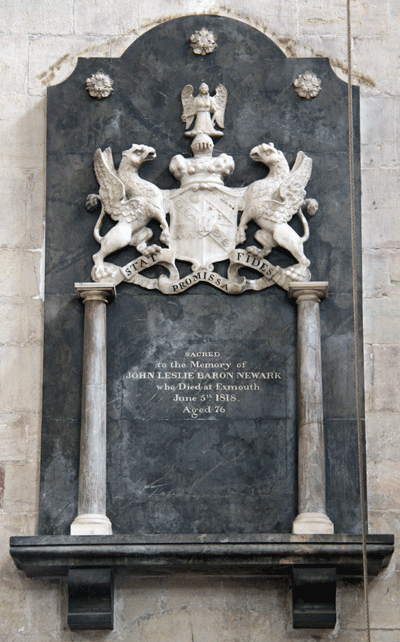 |
 |
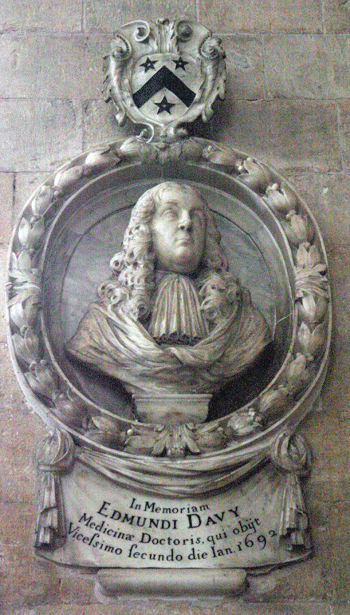 |
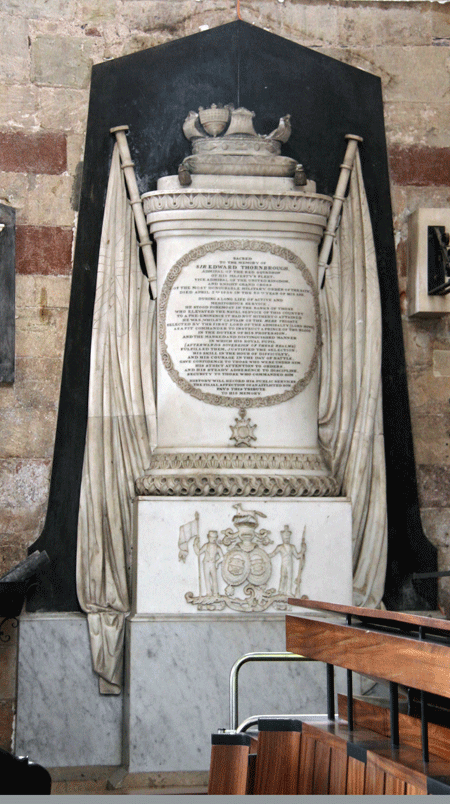 |
|
Left:
James
Northcote RA (1831)
A Plymouth man and a painter:
the effigy by Sir Francis Chantry shows him holding
his palate. He died in London at was buried in St Mary le Bow.
Behind may be seen the simple tablet to
General
Alexander Mercer (1836) Royal Engineers. '...who
mortal remains are deposited near this tablet'. Above Left: John Leslie, Baron Newark (1818) There can't be a more simple inscriptions! Above Central: Cols J Cormick (1868) & C Bennet (1867) Above Right: Dr Edmund Davy (1692) |
||||
 |
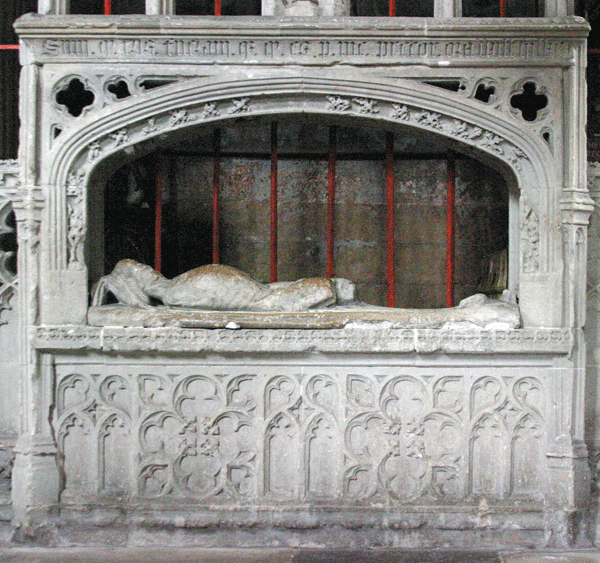 Preceptor Sylke (1508) Chantry chapel: there is only the stone cadaver effigy on a tomb chest. The inscription on the canopy above reads: 'I am what you will be, and I was what you are. Pray for me I beseech you' A preceptor was the master of music |
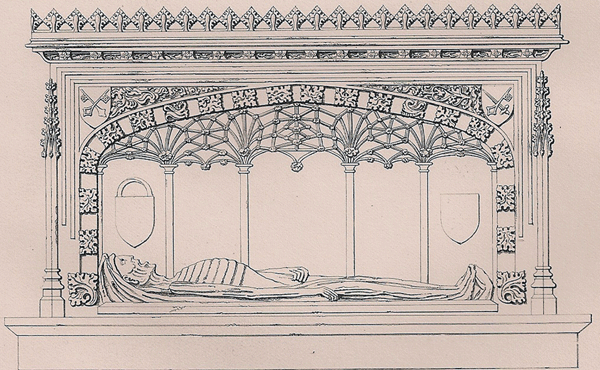 |
 |
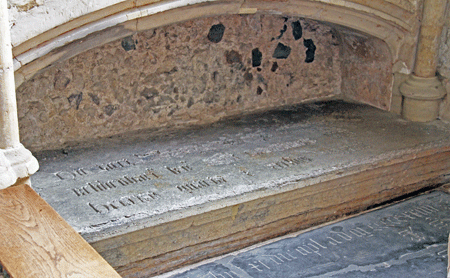 |
 |
| Left:
Captain
Benjamin Dollen (1700) White marble. Note the ship in
full sail below the inscription panel. The design is taken from
a drawing by Nicholas Blassett (ob 1659) who lived and worked in
Amiens, France. Although it is said to have been signed by
Weston, Dr Clive Easter has been unable to detect this signature
and feels it is certainly not in Weston's style. Above: Tomb slab under an arch in the east chapel of the transept. Lettering mostly obliterated. Note the fractured ledger stone on the floor in front of this monument. Right: Bishop John Woolton (1594) Very high up. His actual tomb is in the presbytery. Below Left to Right: 'Near this place is interr'd Being all which a lingering disease could impair...' Sarah Twopenny (1817) of Casterton Parva, Rutland. Caroline Draper Tottenham (1818) of Clifton , Glou. Charlotte Piggott (1823) of Doddershall-Park, Bucks Eliza Bankes Hartopp (1814) 'Died at Torquay...and was inerr'd in a vault near this Spot' |
 |
 |
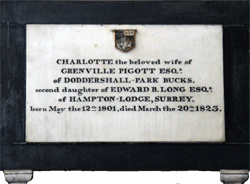 |
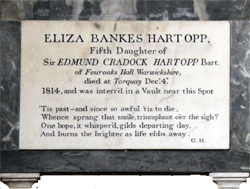 |
| South Transept |
 |
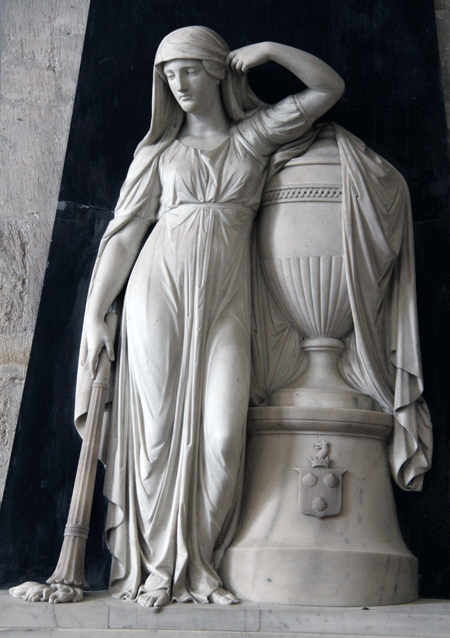 |
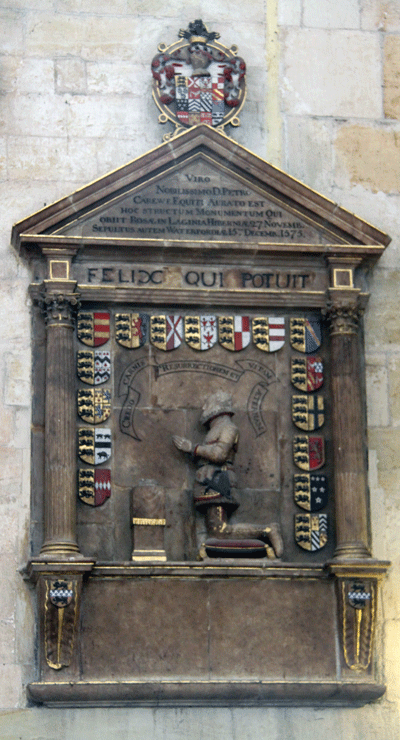 |
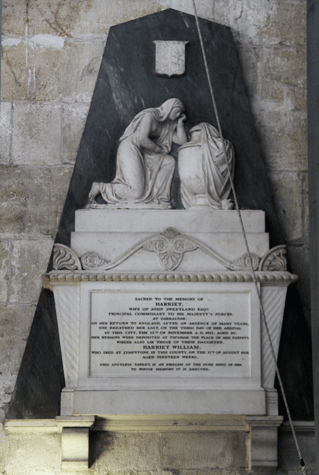 |
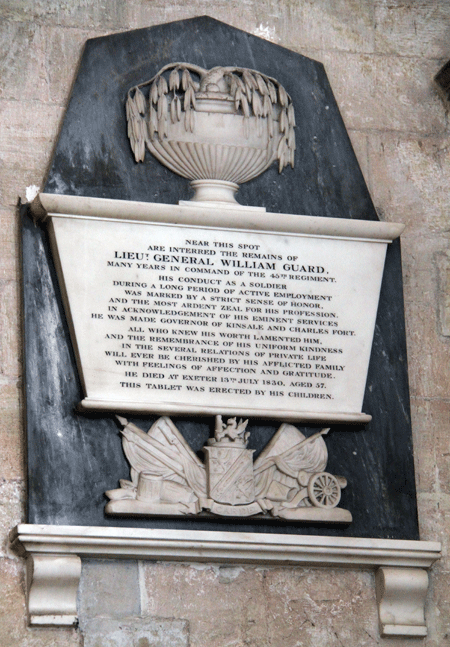 |
| Far Left:
Very Reverend Joseph Palmer (1829) Dean of
Cashel, County Tipperary, Ireland. By Humphrey Hoppe. Above
Left: Close up of standing figure of previous.
Above Centre Left: Sir Peter Carew (1575). Above Centre Right: Harriet Sweetland (1813) 'died within three days after returning to England from Gibraltar where her husband was Commissioner of HM Forces. Buried at Topsham with her daughter Harriet William. Above Right: Lt-Gen William Guard (1830) |
||||
 |
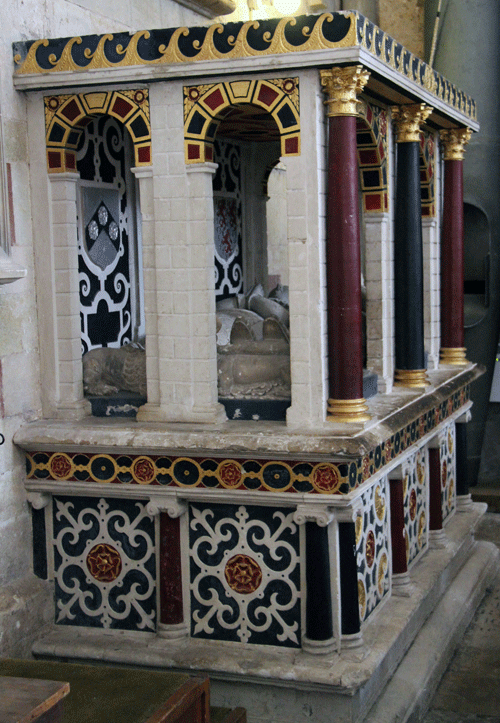 |
 |
 |
| Above Left, Centre & Right Top:
Sir John Gilbert (1596) & Wife.
A squirrel sits at his feet Above Right Bottom: Bishop John 'The Chanter' (1191) One slab of Tournai Marble and one of Purbeck Marble rest on a late 14th century tomb chest Below Left Top: Captain Temple Hardy RN (1814). Younger son of Admiral Sir Charles Hardy and his widow Elizabeth Lucy Hardy (1835). ' his remains are buried near this spot...' Nothing to do with the Hardy of Trafalgar/Nelson fame: that was Captain Thomas Hardy RN and that was the one who didn't write books! Bottom: Elizabeth Mary Furze (1809 age 5) '...lies beneath this tablet...' Below Centre Top: Catharine Kennedy (1809 aged 9) '...lies beneath this urn...' Bottom: Thomas Heberden MA (1843) Canon Residentiary Below Right Top: Eleanor Martin (1812) Widow of Joseph Martin MP and banker; their son and son-in-law were both canons residentiary. '...in this chapel are deposited the remains of...' Below Right Bottom: Archibald Robertson STP (1931) Bishop of Exeter 1903-1916. And Alfred Earle (1918) He was Suffragen Bishop of Marlborough (now in abeyance, subject to London) and simultaneously Rector of Saint-Botolph-without Bishopgate, Rector of St Michael's, Cornwall, and Prebendary of St Paul's. He was installed as Dean of Exeter in 1900, while nominally still holding the London posts. |
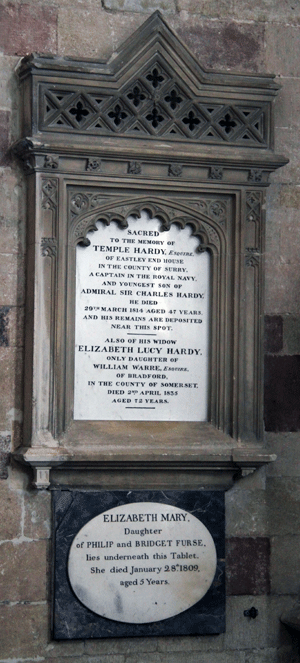 |
 |
 |
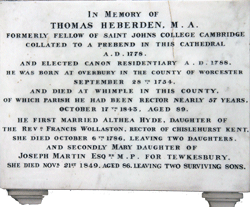 |
 |
|
|
Below: Ralph Barnes (1820) &
Thomas Heberden (1843) Prebendaries and Canons
Residentary. Brass on sill of East Chapel window |

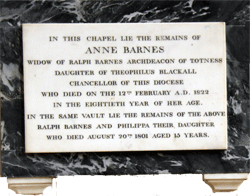 |
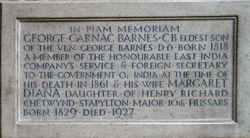 |
 |
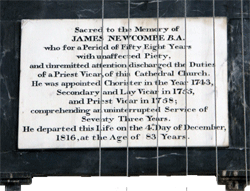 |
 |
| Anne Barnes (1822) Widow of Ralph, Archdeacon of Totness. 'In the same vault lie the remains of the above Ralph Barnes and Philippa their daughter who died August 20th 1801 aged 15' | George Barnes (1861) 'Member of the Honourable East India Company's Service and Secretary to the Government in India' and Margaret Diana (1927). He was the eldest son of Archdeacon Ralph (left) | Philip Salter (1554) Lay-Vicar. 'cut off by accidental death July 21st 1834 in the 31st year of his age.' The vertical lines are supporting wires. | James Newcombe BA (1816) Chorister 1743' Secondary & Lay Vicar 1755 & Priest-Vicar 1758. He served the cathedral 73 years | Anne Barnes (1822), Philippa Barnes (1801), Maria Barnes (1834) & Katharine Anne Barnes (1850) |
 |
 |
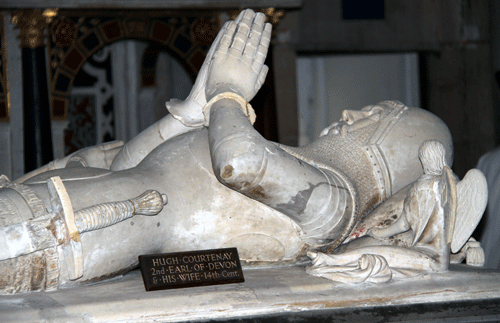 |
 |
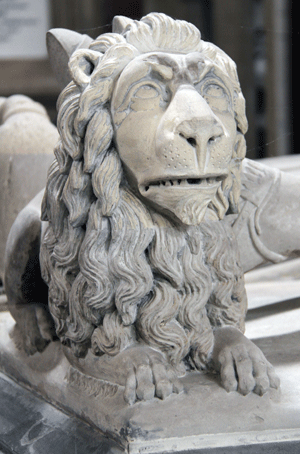 |
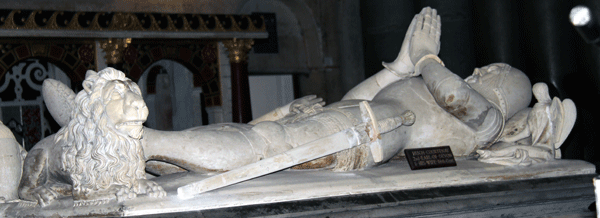 |
| Above & Right:
Hugh Courtney, 2nd Earl of Devon (1377) &
Margaret [Bohun]
(1391) Their son became Archbishop of Canterbury and arranged for their burial in Exeter Cathedral rather than in Tiverton. |
Oringinally in a Courtenay chantry chapel in the nave where a brass indicates the original site. Much restored |
| North Choir Aisle |
 |
 |
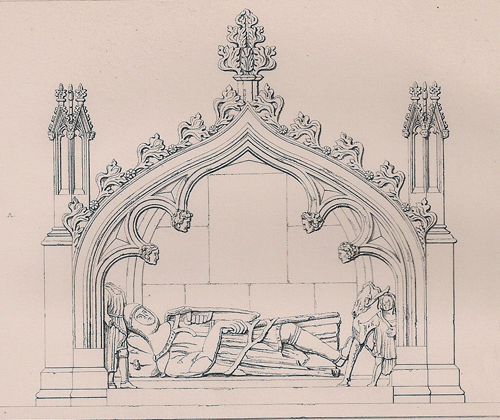 |
|
Sir Richard Stapleton
(1326) Brother of the Bishop; lawyer and judge. Unusual feature: his
squire at the head and his groom holding his horse at the
foot. Note also that this is one of a series of monuments
where the effigy turns outwards slightly. N.B. Pevsner gives the name as Robert (1326) but all other sources as Sir Richard (1326). Further details are given below under Bishop Stapleton. |
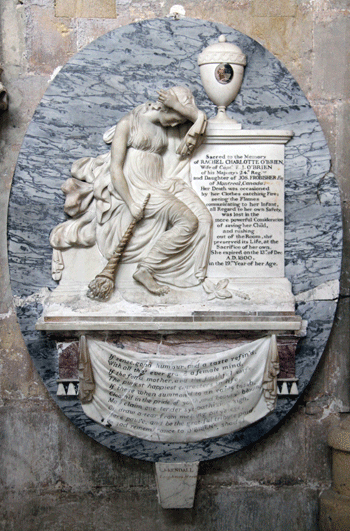 |
 |
 |
 |
| Rachel O'Brien (1800) She died saving her child from a fire at the age of 19. Signed by J. Kendall, the Cathedral Surveyor | Ellsworth Fursdon (1865) Lieutenant 2nd Battalion 9th Regiment of Foot. Died in Honk Kong aged 24. | Rev George Baker (1772) Archdeacon of Totnes and Canon of the Cathedral. Also his daughter Sarah (1760) '...both buried near this place...' Also his wife Mary (1777) and their daughter Martha (1778) | Philip Barton (1796) DD Canon and Sub-Dean of the Cathedral |
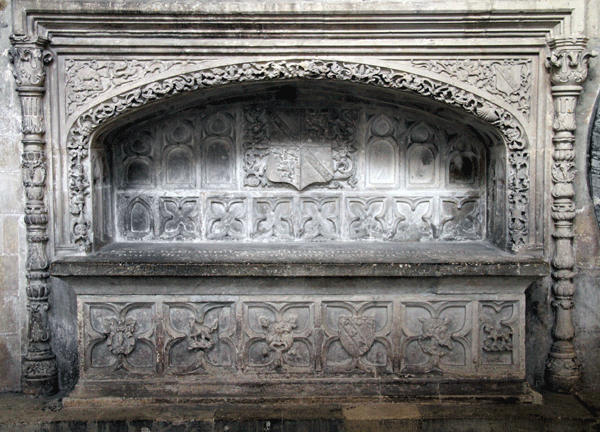  |
 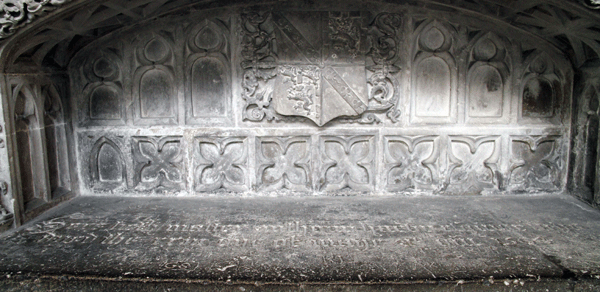 Above Top & Left Bottom: Cadaver effigy behind a grille of contemporary ironwork. This is said to be part of the tomb of Anthony Harvey (1564), whose canopied tomb chest - with no effigy - is shown Left Top & Above Bottom. The details are a mixture of Gothic and Classical design. |
 |
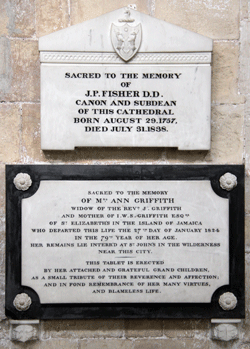 |
 |
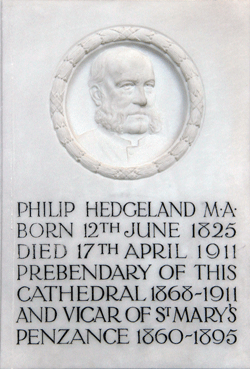 |
 |
 |
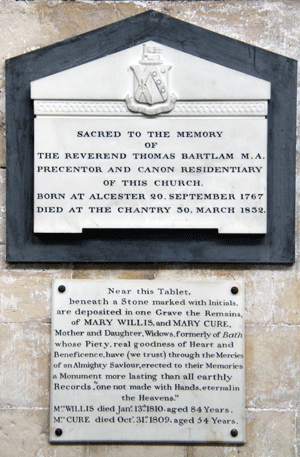 |
 |
 |
|||
| Top: Edward Drew (1793) Barrister '...remains interred near this place.' Also his father Edward, 'who lies beneath' and his mother Dorothea, 'buried in St Martin's Church in this city.' | Top:
J P Fisher DD
Canon and Sub-Dean Below: Mrs Ann Griffith (1824) 'her remains lie interred at St John's in the Wilderness near this city. |
Top: Thomas Skinner LL D (1789) Archdeacon of Totness and Precentor of the Cathedral | Top: Philip Hedgeland MA (1911) Prebendary of this Cathedral and Vicar of St Mary's, Penzance. | Top: Venerable William Hole (1791) Archdeacon of Barnstable; Richard Hole (1803) Rector of Farringdon and Inwardleigh. | Bottom:
Canon John
Rogers (1778) Below: 'Near this stone lies interred the body of' Miſs Henrietta Wilhelmina Wyander Piers (1762 age 22) |
| Bottom: Arthur Corfe Angel (1866) Officer of SS London which foundered in the Bay of Biscay on voyage to Melbourne in a severe gale. Also his wife Anne | Bottom:
Rev Thomas
Bartlam MA (1832) Precentor and Canon of the
Cathedral. Below: 'Below this Tablet beneath a Stone marked with Initials are deposited in one Grave the Remains of' Mary Willis (1810) and Mary Cure (1809) Mother and Daughter, both Widows.' |
Bottom: Susannah Bealey (April 1798 aged 22) '...also in the same grave her only child...' Joseph Pool Bealey (September 1798 aged 18 months) Also her mother Ann Susannah Baker (1800) | Bottom: Basil William, Lord Dyer (1894) | Bottom: Edward Force (1879) Chapter Clerk. |
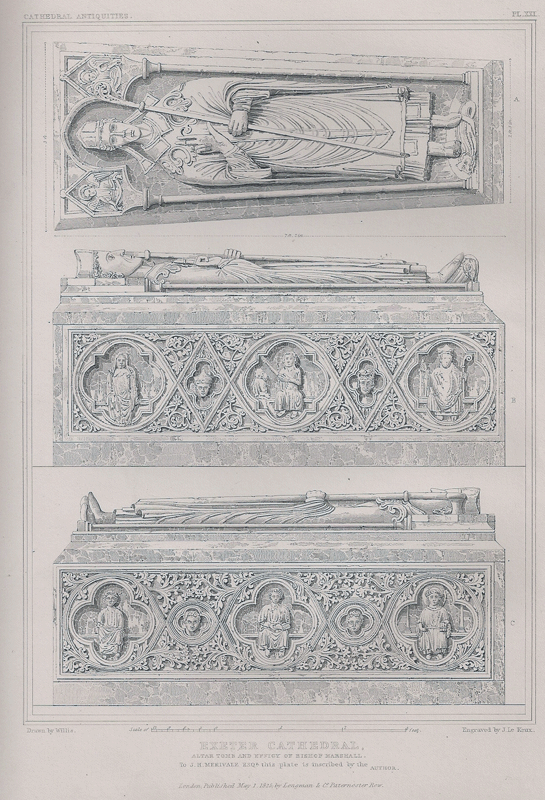 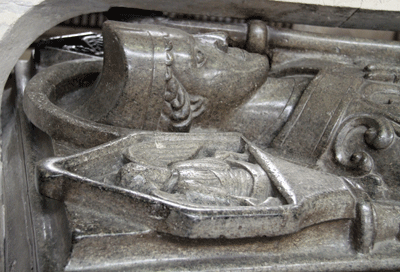 . |
 |
 |
|
 |
|
 |
|
| Above & Right: Bishop Henry Marshal (1206) was brother of William Marshal, Earl of Pembroke and became the 8th Bishop of Exeter. Purbeck marble coffin shaped slab with low relief effigy on later Purbeck marble tomb chest with three seated figures in quatrefoils: Christ in Majesty, St Peter and Saint Paul. Separate side slabs in this aisle are part of the monument. The Norman cathedral was completed under Henry Marshal's episcopate and he taxed every household in the diocese one halfpenny each Whitsuntide towards the Cathedral's upkeep |
 |
 |
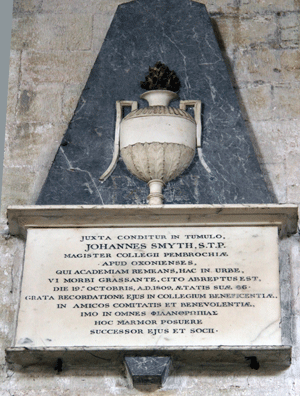 |
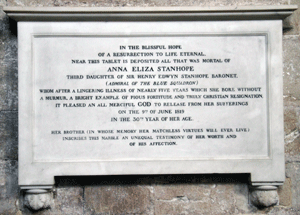  |
| Robert Hall (1667) Cathedral Treasurer; son of Bishop Hall | John Grant DD (1796) Prebendary, Canon Vicar & Rector of Kingsdown | John Smyth DD (1809) Master of Pembroke College, Oxford. | Top:
Anna Eliza
Stanhope (1819) Bottom: Rev George Moore MA (1809) Archdeacon of Cornwall, Canon Residentiary and Vicar of Heavitree. |
 |
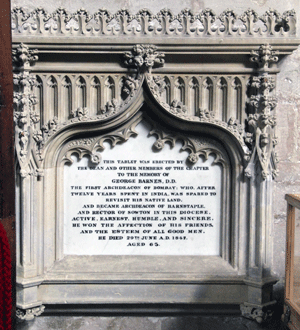 |
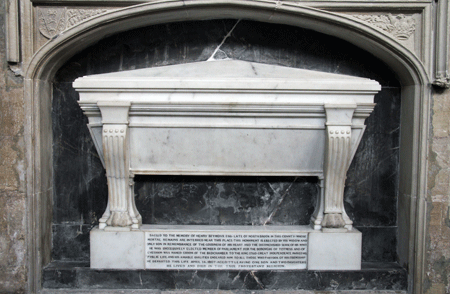 |
| Above Left:
Felicity
Jemima (1813)
Daughter of William Lord Beauchamp of
Powyke. '...in a vault below...' Above Right: Rt Hon Lady Mary Catherine Meyers (1802) '...leaving a Son and a Daughter to the Care of her afflicted Husband.' Right: George Barnes DD (1847) First Archdeacon of Bombay and then later Archdeacon of Barnstable and Rector of Sowton. Far Right: Henry Seymore (1807) |
 |
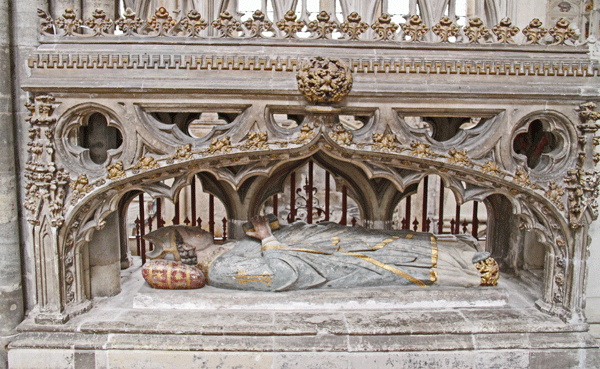 |
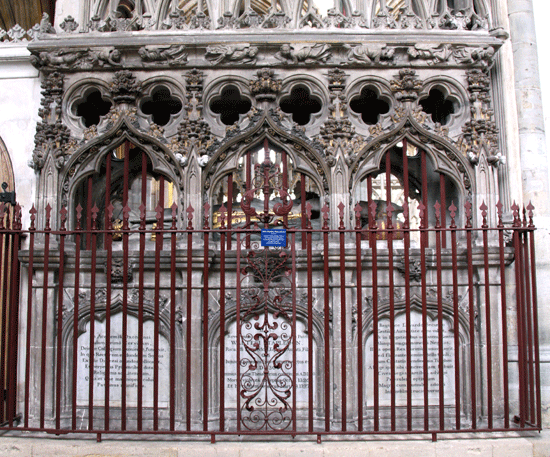 |
 |
 |
|
Bishop Walter de Stapleton
(1326) 15th Bishop of Exeter. Another monument
which lies between the aisle and chancel and both aspects
are shown here. The monument is best seen from the chancel so
ask a member of staff may you go beyond the ropes. The
Bishop holds a book and looks at a painted of the Risen
Christ, depicting the Five Holy Wounds, which is on the arched
ceiling above him. He was the younger brother of Sir Robert Stapleton, whose monument is near-by, founder of Exeter College, Oxford and Lord High Treasurer of England. They were born in Monkleigh, Devon. |
| The Killing of the Stapleton Brothers |
| During the war bewteen King Edward II
and Queen Isabella, the King had appointed Bishop Stapleton
to be Keeper of the City of London. The Londoners were loyal
to the Queen and regarded members of the establishment -
such as the Bishop - responsible for the misgovernment of
the country. The bishops had gathered in Lambert, south of the Thames, to arrange a mission of two of them to cross the river and convene peace talks between the King and Queen. Bishop Stapleton and the Bishop of London volunteered to take this journey into hostile territory and crossed the river to meet at Blackfriars just outside to City gates. The Londoners met a the Guildhall and planned to ambush the bishops and loot the merchants of the City. Bishop Stapleton and his brother Richard, one of the justices, were ambushed and the latter was dragged from his horse and murdered by the mob. The Bishop fled to Saint Paul's Cathedral but he was persued by the mop, dragged out of the church and beaten and butchered to death. He was beheaded and his body flung on a dung hill. However his supporters rescued the body buried it by the banks of the Thames. Six months later Queen Isabella, not approving of the action of her supporters, ordered thay the Bishop's body be buried with honour in his cathedral. |
 |
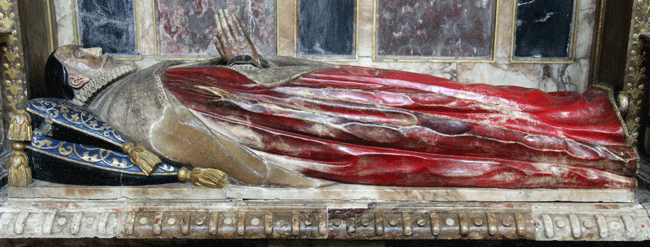
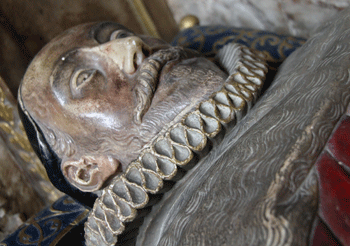 |
|
 |
 Far Left & Top Row Above: Bishop Valentine Carey (1626) 39th Bishop. Coloured alabaster. Although said to have been a 'prudently and courtly man' he became involved in a long and apparently fruitless dispute with Exeter Corporation over their refusal of his request to have a private dor in the City walls. Bottom Row Above: Bishop Edmund Lacy (1453) 22nd Bishop. The tomb lies between the aisle and chancel (both aspects above) and there was originally a brass on the marble slab, but now just the matrix; this was a figure of a bishop with a crozier. Bishop Lacy, as then Dean of the Royal Chapel, accompanied King Henry V on his campaign in France, being at Agincourt. There is a public house in Chudleigh, Devon named after him. |
|
|
.South Choir Aisle |
 |
 |
 |
|
Bishop William Buller DD (1796) |
From Left to Right: Bishop George Wyndham Hamilton Bruce (1896) 'Sometime Bishop of Bloemfontein and after wards a pioneer missionary and first Bishop of' Mashonal ... driven by the fever from the missionary fields of South Africa' Afterwards Assistant Bishop of Exeter. John Ross DD (1792) 55th Bishop of Exeter. Charles Isaac Atherton MA (1907) Treasurer and Canon. Warden of the Society of Mission Clergy. | Dr Edward Cotton
(1675) Canon Residentiary and Treasurer Son of the Precentor; Grandson of the Bishop |
 |
Lieutenant-General John
Graves Simcoe (1806) He was the first Lieutenant Governor of Upper Canada and founded Ontario. The large wall tablet - by John Flaxman -has a portrait bust and figures of a soldier and a native Canadian. |
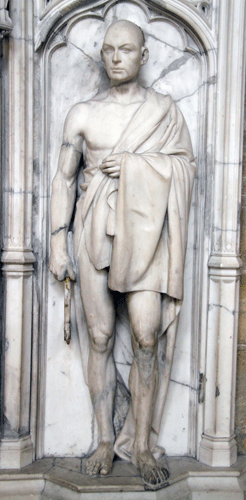 |
 |
||
| Lt-Gen Simcoe was buried in the Wolford Chapel at Dunkeswell, near Honiton, Devon and which had been built on his commission in 1802. The chapel was part of the Simcoe estate and following Simcoe's death it remained with the family until 1923 but was eventually sold and parts broken up. The chapel and most of the estate was acquired by publisher Sir Geoffrey Harmsworth and in 1966 he decided to donate it to the John Graves Simcoe Memorial Foundation on behalf of the people of Ontario. He presented the deeds to the then Premier of Ontario, together with a deed making a permanent right of access. In 1982 the chapel was acquired by the Ontario Heritage Trust. The chapel is this the property of Ontario and flies the Canadian flag. |

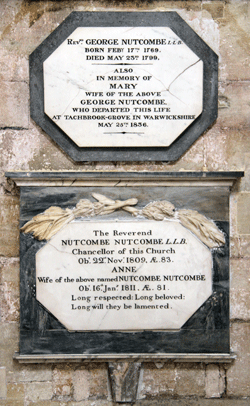 |
 |
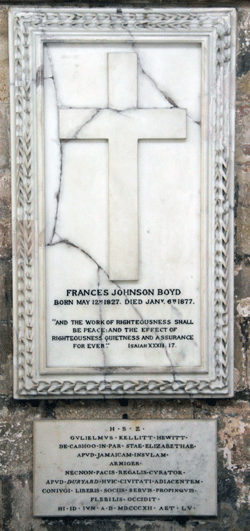 |
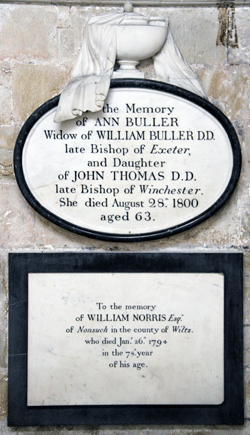 |
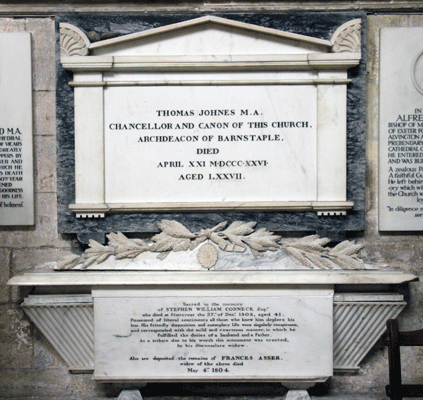 |
||
| Top: Revd George Nutcombe LL B (1798) & Wife Mary (1836) | Top: Elizabeth Daubeny (1814) Wife of John LL D, Advocate of Doctors' Commons | Top: Frances Johnson Boyd | Top: Ann Buller [Thomas] (1800) Daughter of a Bishop of Winchester; widow of a Bishop of Exeter. | Top: Thomas Johnes MA (1826) Chancellor and Canon; Archdeacon of Barnstaple | ||
| Bottom: Revd Nutcombe Nutcombe LL B (1809) 'Chancellor of this Church' & Wife Anne (1811) | Bottom: Louisa Harford (1803) | Bottom: William Kellitt Hewitt (1812) | Bottom: William Norris (1794) | Bottom: Stephen William Corneck (1802) & his wife Frances Asser (1804) |
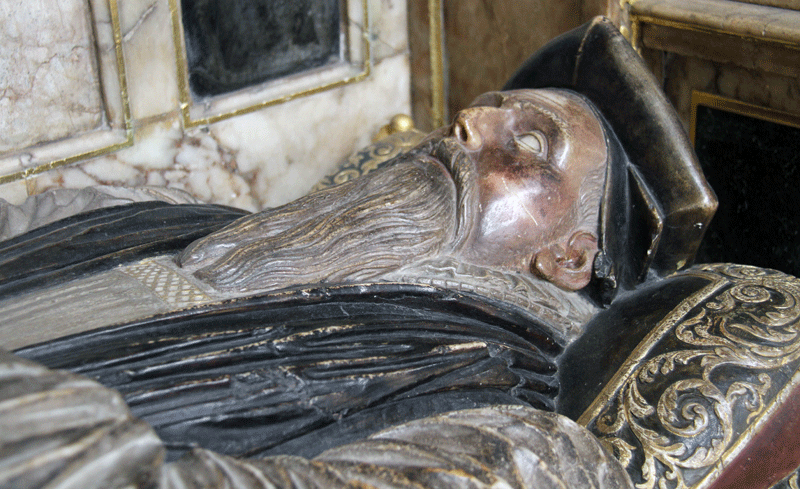 |
 |
|
Bishop William Cotton ( (1621) 49th Bishop of Exeter. He taught at Eton School, where he had been educated, for seventeen years; it is said that he treated the clergy like school boys. Painted alabaster.. |
|
 |
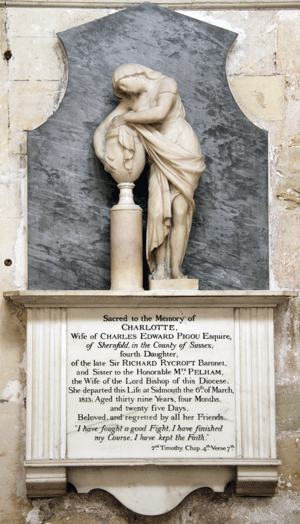 |
 |
 |
 |
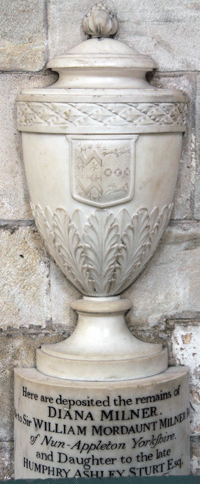 |
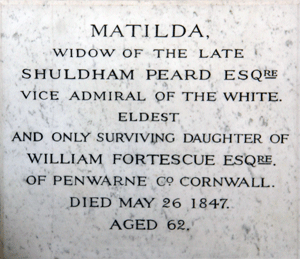 |
||||
| Charlotte Pigou (1813) | Sarah Price Clarke (1810) 'Her mind possessed an energy which does not often mark the female character' Also called 'a formidable lady.' |
Top:
Prebendary John
Erskine Binney MA (1913) Bottom: Matilda Peard (1847) |
Laura Ferdinand (1789) Daughter of Bishop Frederick Kepple |
Diana Milner (1805) Of Nun Appleton, Yorkshire. 'Here are deposited the remains of...' |
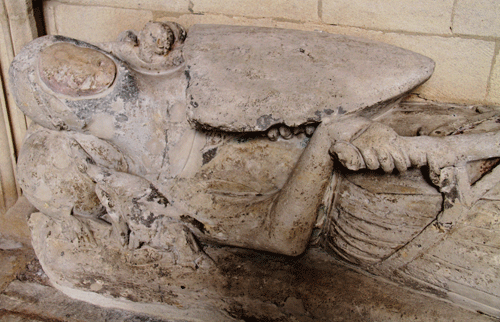 |
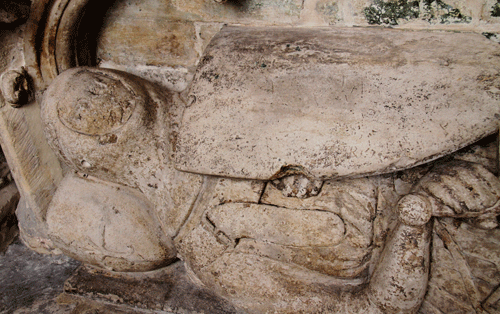 |
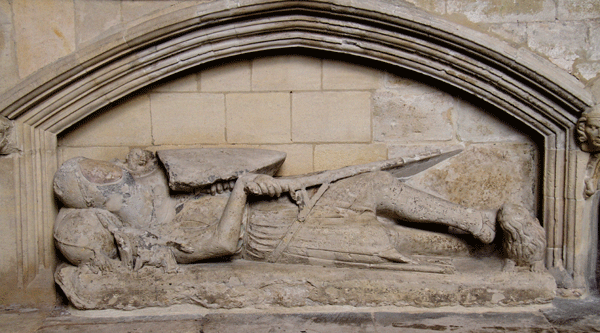 |
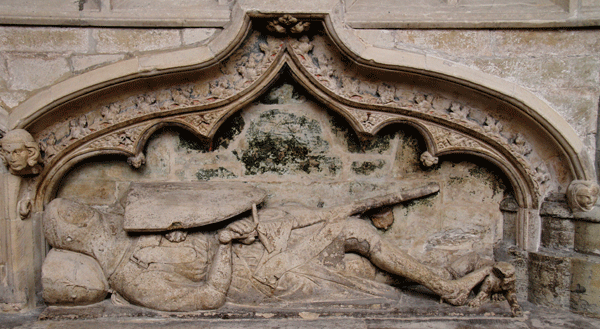 |
| Said to be Sir Humphrey de Bohum, Earl of Hereford (1322) | Sir Henry de Raleigh (1302) |
| Similar effigies but with subtle differences; note how both turn slightly like the Stapleton effigy in the opposite aisle | |
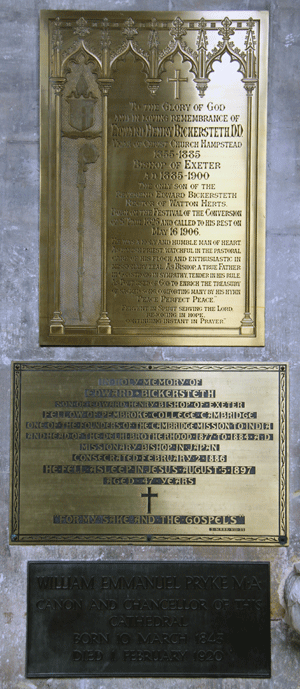 |
 |
 |
 |
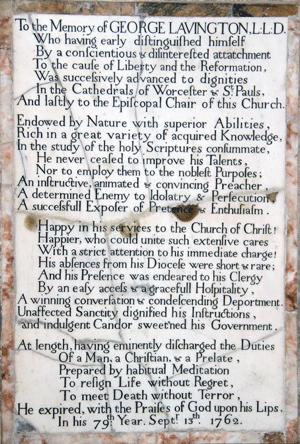 |
 |
 |
 |
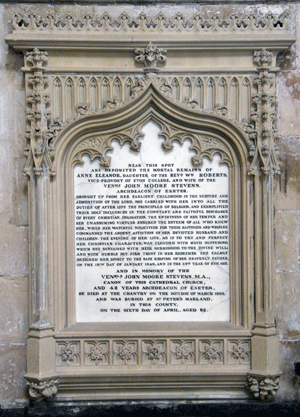 |
|||
 |
|||||
| First Column
from Top Downwards: 1.
Dr Edward Henry
Bickersteth (1906); 2.
Edward Bickersteth (1897) Son of the Bishop,
himself a missionary bishop in Japan; 3.
William Emmanuel Pryke MA
(1920) Canon and
Chancellor Second Column as above: 1. Ernest Gray Sandford (1910) Canon and Precentor; Archdeacon of Exeter. 2. Ralph Barnes AM (1820) 'In this Cathedral are deposited the remains of...' Vicar of Herberton and Heavitree, Canon of this Cathedral, Archdeacon of Totness, and Chancellor of the Diocese. And his Wife Anne. 'Near the same place are deposited the remains of...' Third Column as above: 1. Alfred Earl DD (1918) Bishop of Marlborough and Dean of Exeter. Buried at West Alvington. 2. Arthur Simms (1921) Archdeacon of Totness and Canon of this Cathedral. 3. William Bacon (1840) The fourth row seems to reflect the preceding on; I wonder how many times the juxtaposition of the two tablet on the bottom row been noticed. Fourth Row. 1. Rev'd William David MA (1909). Priest Vicar of the Cathedral. Custos of the College of Vicars Choral. 2. Herbert Read Sculptor responsible for the chancel seats. Latin text. 3. Lt Henry Rice RN (1808) Fifth Row: 1. Bishop George Lavington LL D (1762) 51st Bishop of Exeter and chaplain to George I. An early opponent of Methodism who entered a long correspondence on the subject. 2. Venerable John Moore Stephens MA (1865) Archdeacon of Exeter. Buried at St Peter's. And his wife Anne Eleanor Stephens (1849), '...near this spot are deposited...' Sixth Row: 1. Archibald Boyd DD (1883) Dean 2. Michael Ferrebee Sadler (1895) Receiver of Honiton, Proctor in Convention for this Diocese, Prebendary of Wells. The two bronzes below are reproduced in the centre two rows |
 |
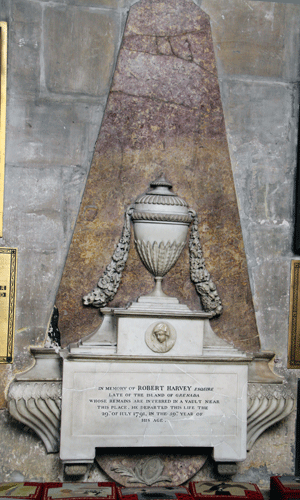 |
 |
 |
| Left:
Dr Nicholas
Hall DD (1709) Cathedral Treasurer; son of Robert
Hall Above: Robert Harvey (1791) '...late of the Island of Granada...whose remains are interred in a vault near this place. |
Right:
Bishop
Stephen Weston (1742) 52nd Bishop of Exeter. And
his wife Lucia (1741) Below the upper and
main part of the monument, and partly obscured is added their
daughter Margaret (1762) By Thomas Ady. Above: Dorothy Bennet (1736) |
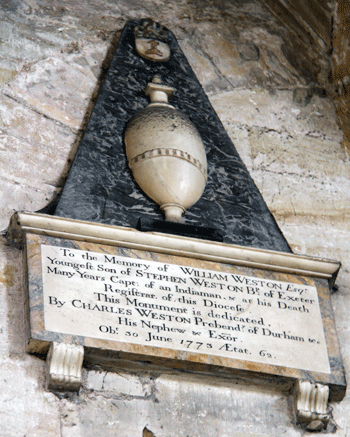 |
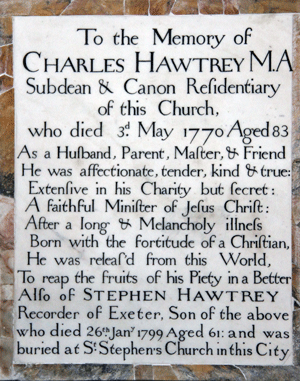 |
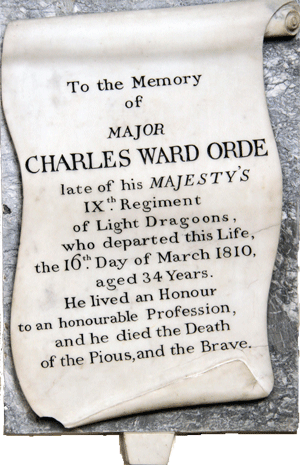 |
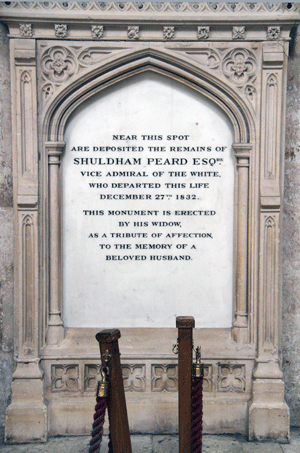 |
| Above:
Charles Hawtrey MA (1770) Subdean & Canon
Residentiary; also his son Stephen
(1799),
who was buried in St Stephen's Church Left: William Weston (1775) ' ...Capt. of an Indiaman...' Son of Bishop Weston |
Above:
Major Charles Ward Orde (1810) IX Regiment
of Light Dragoons Right:Vice-Admiral Shuldham Peard (1832). |
| There is a large brass on the floor of the south chancel aisle to Sir Peter Courtenay (1409) 7th son of the Earl of Devon. Although virtually intact it is in a very worn condition and difficult to make out let alone photograph. I will attempt to photograph it again on my next visit but if this proves unsatisfactory yet again I will execute a drawing. |
| The Chancel |
| Several monuments lie between the aisles and the chancel: two shown below lie entirely in the chancel while the other is best seen from the chancel. The other monuments which lie between both are dealt with in the section on the aisles |
 |
 |
| Bishop Berkely (1327). The 16th Bishop of Exeter. Tomb chest with Purbeck Marble slab which lies between the chancel, from where it is best seen, and the south aisle. Although Pevsner (The Buildings of England: Exeter) states the brass matrix on the slab is of 'a demi-figure in a trefoil', I cannot make this out: it looks like a cross in low releif within a circle'. | |
 |
 |
| Bishop Woolton (1594) The 37th Bishop of Exeter. Tomb chest eith a black marble top with inscription. His tablet is in the North Transept. South side. | Bishop Bradbridge (1578) The 36th Bishop of Exeter. Tomb chest with inscription. North Side. |
| The Lady Chapel |
| Two Early Bishops |
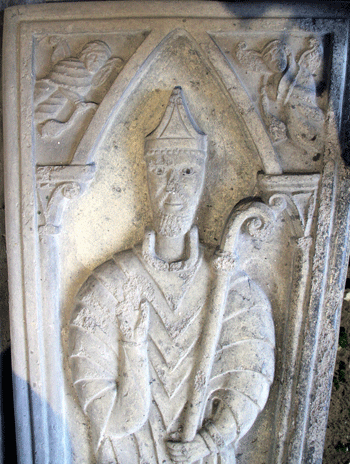 |
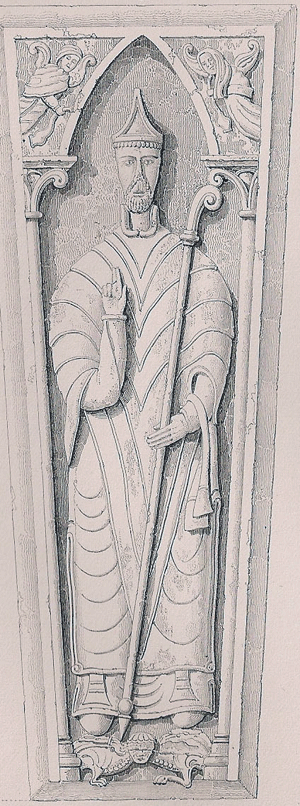
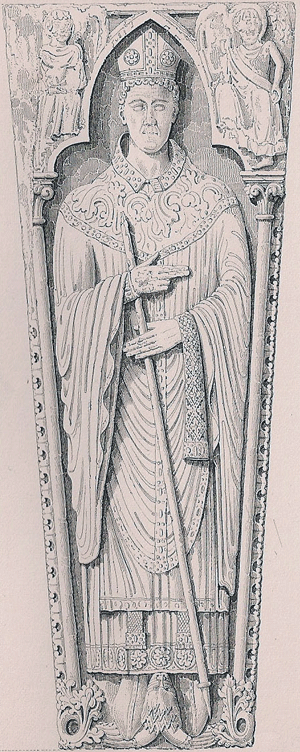 |
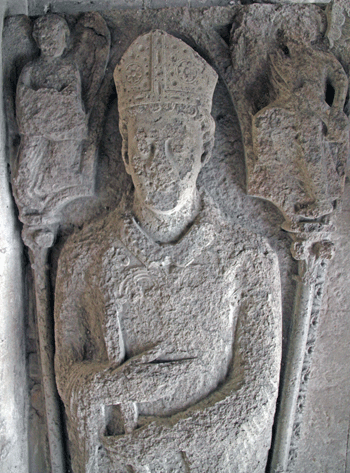 |
| Above, Right
& Below: Tomb chest with effigy in very low releif of
either: Bishop Bartholomeus Iscarus (1184), 6th
Bishop of Exeter, or Leofric (1070), the 1st
Bishop. The latter transferred the see to Exeter from Crediton
in 1133, the former being a walled city while the latter was
then a village. He also united the Diocese of Devon with that of
Cornwall. (see below) |
Above, Left and Below:
Simon of Apulia. 9th Bishop of Exeter. Purbeck Marble effigy but in higher relef than that of Iscarus. He was an Italian and was appointed as part of a deal between King John and the Pope following the lifting of the interdict on England. |
|

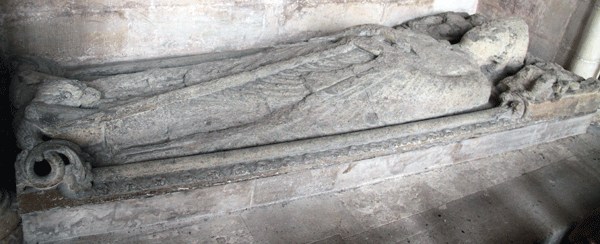 |
||
| Diocese of the South-West Peninsula |
| The early church organisation of Devon and
Cornwall is somewhat obscure. The diocese of Sherbourne (in
Dorset) was created around 705 and included Devon and Cornwall
as well as Dorset and Somerset. In about 900 the diocese of
Cornwall and Devon were split off this large diocese with the
Devon See being at Tawton (near Barnstaple), now Bishops's
Tawton. The Devon See was again moved to Crediton in 912 and
this was finally moved to Exeter by Bishop Leaofric in 1133, who
also united the Dicese of Devon and Cornwall. In the 19th century the dioceses of Devon and Cornwall where again split with the creation of the Dioces of Truro in Cornwall. Crediton now has a suffragen bishop, subject to the Bishop of Exeter. |
| Three Later Medieval Bishops (and a 20th CenturyDean) |
 |
  |
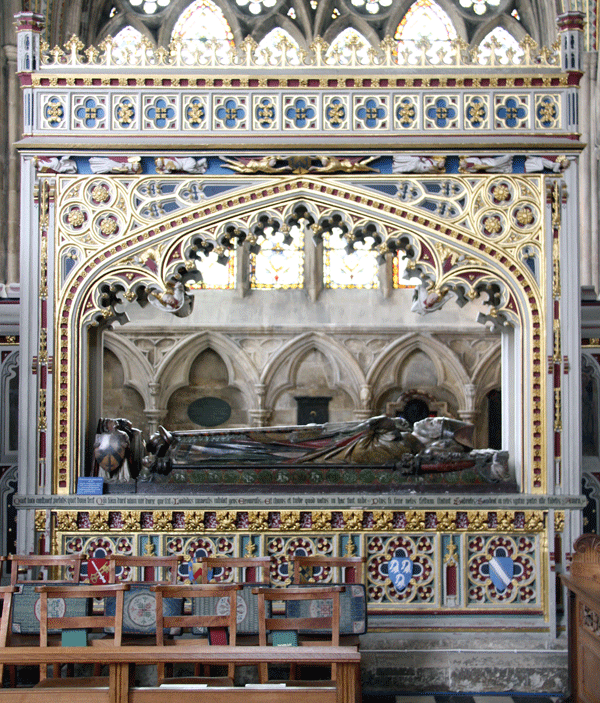 |
| Above and the Left Hand Column
Below Bishop Stafford (1419) 19th Bishop of Exeter. Alabaster effigy, polychrome. Note the fine 'gablette' over the head. The tomb chest and canopy are a latter addition to match those of Bishop Branscombe. |
Top: Bishop Quinel
(1291). Incised marble floor slab. He began rebuilding
the cathedral as it now appears. Bottom: Dean Henry Reginald Gamble DD (1931) He was mayor of Chelsea 1908-9 |
Above and the Right Hand Column
Below Bishop Walter Branscombe (1280) 12th Bishop of Exeter called Walter the Good. The effigy may be of basalt and shows original colouring. The tomb chest, canopy and the separate angel at the feet are additions of 1442 |
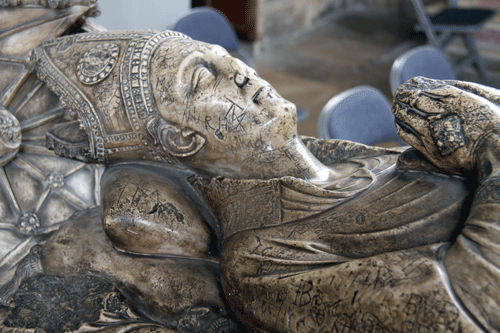 |
 |
 |
 |
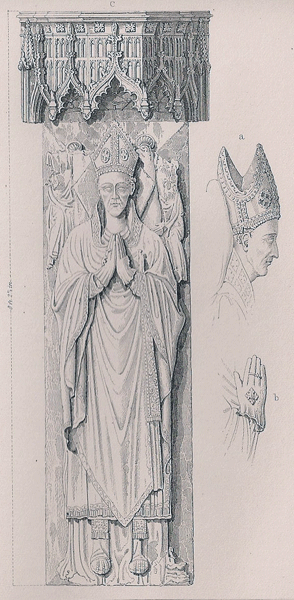 |
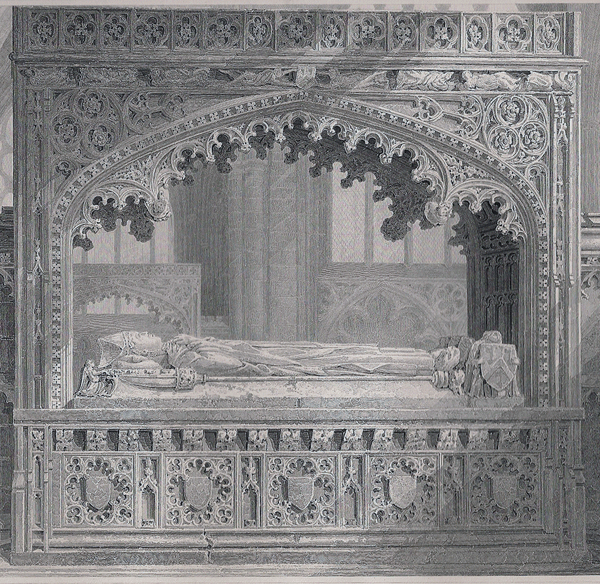 |
| An Early 17th Century Couple |
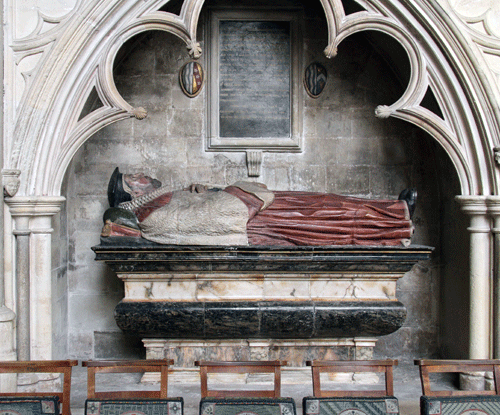 |
 |
 |
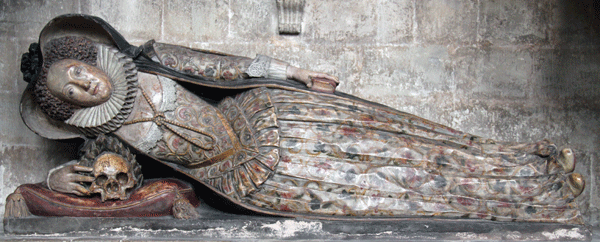 |
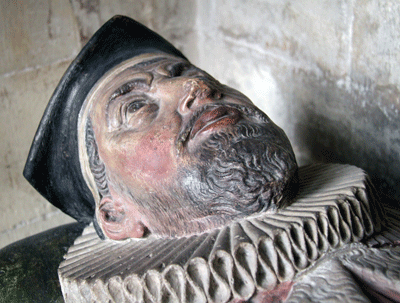 |
|
 |
| The Retrochoir |
 |
 |
| Dr James Bidgood MD (1625-1692) A famous physician who died in Rockbeare and was said to be worth £25,000 - £30,000 at his death. His father was poisoned by a servant |
James Raillard (1692) A Swiss who was granted English citizenship by Parliament. An Exeter merchant |
| North East Chapel |
|
 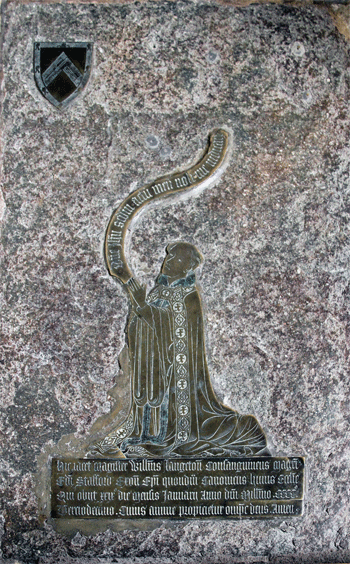 |
||||||||||
| South East Chapel |
 |
 |
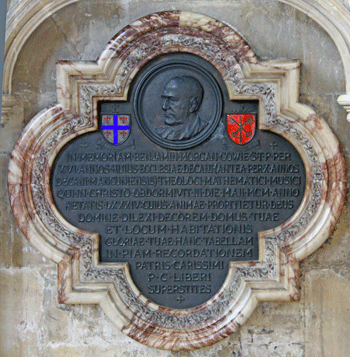 |
 |
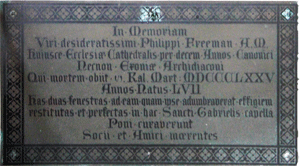 |
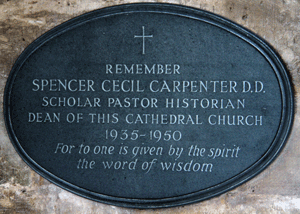 |
||
| Very Reverend Thomas Hill MA (1861) Dean | Top: Ann Freeman (1897)
Wife of Philip below Bottom: Philip Freeman AM (1875) Archdeacon |
Top: Benjamin Morgan Cowie
DD (1900) Dean Bottom: Spencer Cecil Carpenter DD (1950) Dean |
Francis Charles Hingeston-Randolph
MA (1910) Rector of Ringmore & Prebendary of this Cathedral |
| The Speake Chantry (North of Retrochoir) |
 |
 |
| Sir John Speake ( 1519) He was said to have been knighted for his wealth not for his prowess in warfare. He was a friend of Bishop Oldham and their two tombs form a symmetrical pair (see below) |
| The Oldham Chantry (South of Retrochoir) |
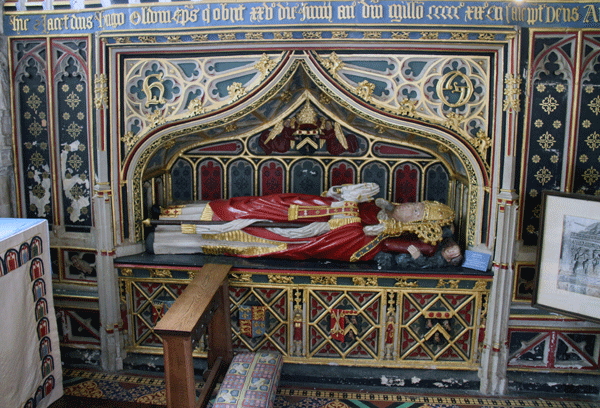 Bishop Oldham (1519) The 30th Bishop of Exeter |
 |
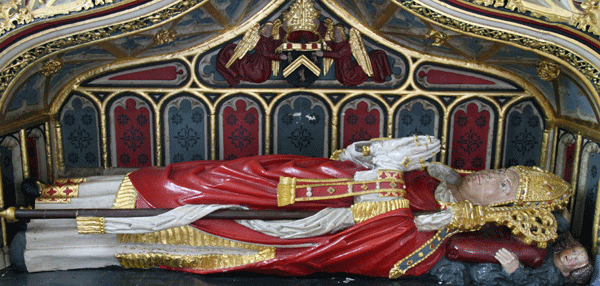 |
| The Refectory |
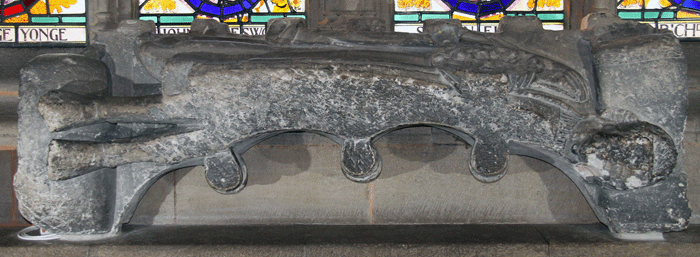
| Look carefully at
the window sill in the cathedral refectory. On it rests
what initially looks like the top of an arch but you can also see it
incorporates part of a medieval effigy - either an early knight or a
male civilian, with the head and feet still resting on an
unidentifiable structure. There is an interesting tale
about this: the notes below are based on a short referenced
article by Dr Andrew Sargent, which appeared in
Church Monuments Society Newsletter, Vol 31 No 2, Spring
2016, to which you should refer for further details and
references. See the Church Monuments Society's web site for
copies of the Newsletter. Below and Left is a coffin lid with any inscription or markings obliterated and which noe leans agains the wall of the refectory. |
 |
From Medieval Civilian to Later Arch of Even Earlier Bishop to Refectory Windowsill |
|
Leofric, who died in 1072, was the first bishop of Exeter
having moved the see in 1049 from Crediton to Exeter and
to the existing Saxon monastic church of Saint Mary and St
Peter there. Leofric was buried in the crypt of his cathedral
although no grave or monument may be seen today. The structure on the window sill is the back of the canopy and we can see that is was carved out of a medieval monument with the effigy partly destroyed; in fact this is the back of the canopy which would have faced the wall and been left partly unworked. If we could turn in round we would see the front of the canopy with the inscription still visible this was clearly smoother and so easier for the mason to work. I should like to thank Dr Andrew Sargent for telling this interesting tale in the Newsletter. |
